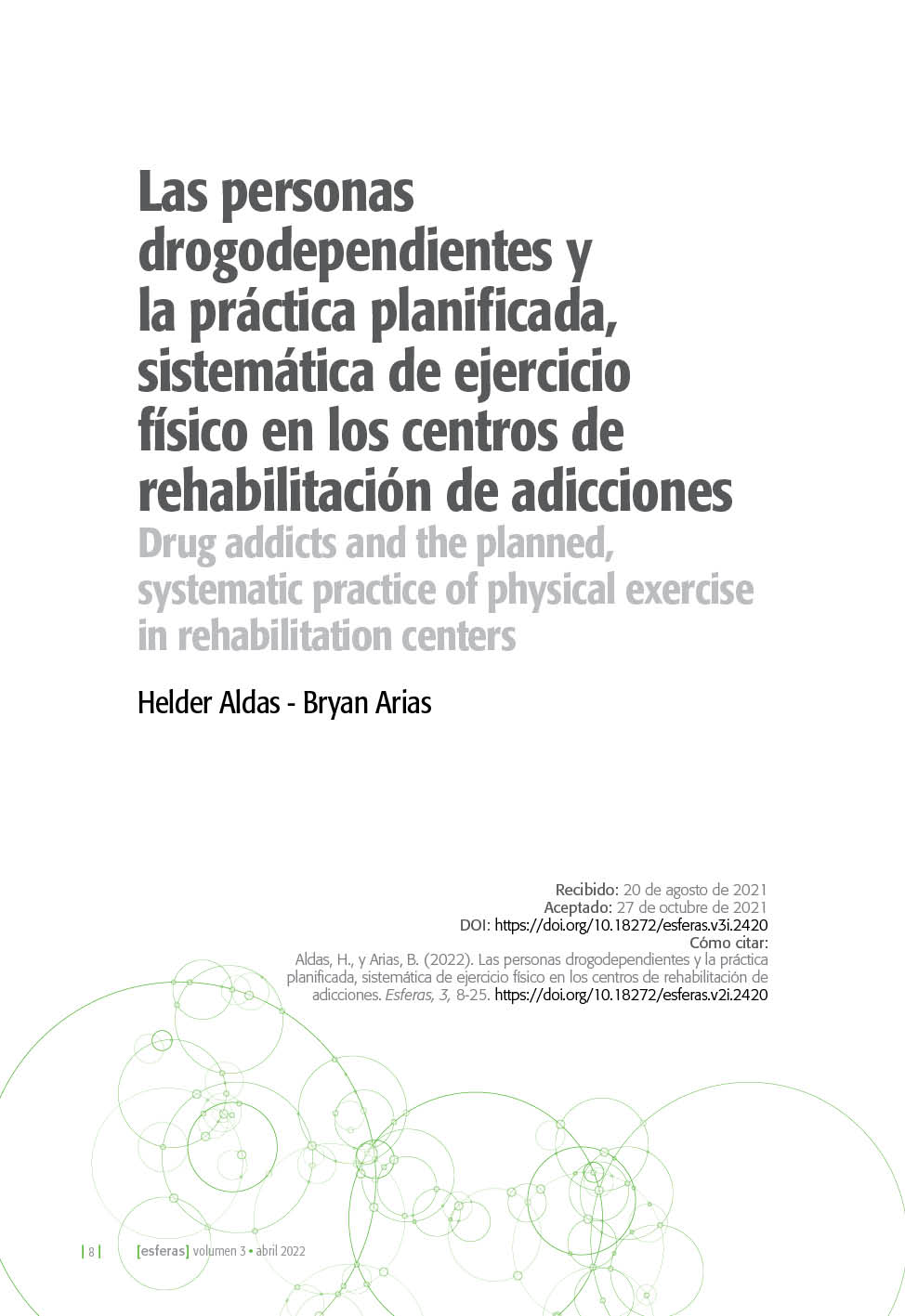Drug addicts and the planned, systematic practice of physical exercise in rehabilitation centers

Published 2022-04-04 — Updated on 2023-02-01
Versions
- 2023-02-01 (2)
- 2022-04-04 (1)
Keywords
- physical exercise,
- sports,
- drug addiction,
- rehabilitation centers
How to Cite
Copyright (c) 2022 Helder Aldas Arcos, Bryan Jonnathan Arias Maldonado

This work is licensed under a Creative Commons Attribution-NonCommercial 4.0 International License.
Abstract
The planned and systematic practice of physical exercise and sports in addiction rehabilitation centers is deficient. The objective of this study is to reveal the intention of patients in addiction rehabilitation centers towards the planned and systematic practice of physical exercise and sports as a key factor. Sixty people between the ages of 17 and 72 years, with a mean of 34 years and a standard deviation of 14, from two important rehabilitation centers in the province of Azuay participated in the study. A questionnaire object of study previously validated by specialists in the area was applied. The results show that the majority (85%) of the patients of these addiction rehabilitation centers intend to practice physical exercise in a planned and systematic way two to four days a week due to the benefits that this practice has in their rehabilitation process. Furthermore, 98.3% of the surveyed population agrees that this type of practice contributes to the use of their free time as a way of living together within a society without using drugs. It is concluded that the planned and systematic practice of physical exercise and sports for people in the process of addiction rehabilitation is essential for the proper use of free time and mainly as an alternative to inhibit anxiety due to the absence of psychotropic drugs since physical exercise generates chemical substances such as dopamine, serotonin, endorphins, adrenaline, and noradrenaline, which produce similar sensations that people in the process of drug use rehabilitation need to feel.
Downloads
References
- Abalde, N., y Pino, M. (2016). La influencia de la actividad fisica y el sobre peso en el rendimiento académico: Revisión Teórica. Sportis Revista técnicocienticico del deporte escolar.Educacion Fisica y psocomotricidad, 21, 147-162.
- Biodi, R. (2007). La importancia de la actividad física en el tratamiento de deshabituación a las drogas. Alcmeon, Revista Argentina de Clínica Neuropsiquiátrica, 14(2), 82-89. https://www.alcmeon.com.ar/14/54/10_Biondi.pdf
- Centelles, L. (2009). La actividad física como factor rehabilitador. Revista digital Ef deportes, 13(128). https://cutt.ly/eQABdsG
- Chicaiza Chicaiza, J. (2020). Ejercicios físicos para reeducar el control motor en pacientes adultos de 18 a 65 años bajo el consumo de marihuana. Trabajo de Titulación, Universidad Central del Ecuador. https://cutt.ly/MQA1jmv
- Ciccolo, J., Dunsiger, S., Williams, D., Bartholomew, J., Jennings, E., Ussher, M., ... Marcus, B. (2011). Resistance training as an aid to standard smoking cessation treatment: A pilot study. Nicotine & Tobacco Research 13(8), 756-760. https://doi.org/10.1093/ntr/ntr068
- Coello, C., y Angulo, C. (2018). Preparación física deportiva como terapia para jóvenes de 15 y 16 años de edad con tratamiento por consumo de droga. Tesis de Licenciatura, Universidad de Guayaquil, Guayaquil. https://cutt.ly/wQAB2BQ
- Cortés Ibáñez, I., y Marín Navarro, T. (2010). Efectos del ejercicio físico sobre el organismo. Efdeportes 15(148), 1. https://cutt.ly/qQANqK8
- De la Cruz Sánchez, D., Moreno Contreras, M., Ortega Pino, J., y Martínez Santos, R. (2011). Actividad física durante el tiempo libre y su relación con algunos indicadores de salud mental en España. Salud Mental 34(1), 45-52. https://cutt.ly/WQA0yJ6
- Flores, C., y Rivas, N. (2019). Centros de tratamiento de adicciones: el peligroso limbo entre la legalidad y la clandestinidad. FES. https://cutt.ly/hQA2JO6
- García Canto, E., Rosa Guillamon, A., y Nieto López, L. (2021). Nivel de actividad física, consumo habitual de tabaco y alcohol, y su relación con la calidad de vida en adolescentes españoles. Retos 39(1), 112-119. https://cutt.ly/QQA1nfw
- Ley, C. (2003). Actividad física y deporte en la terapia de drogodependencias: Un resumen de la situación y posibilidades en España y Alemania. Revista Espanola de Drogodependencias, 358-371. https://cutt.ly/yQANU6a
- Moreno Murcia, J., y Cutre Coll, D. (2009). Deporte, intervención y transformación social 2009. Shape. https://cutt.ly/0QAND8o
- Moreno Murcia, J., Águila Soto, C., y Borges Silva, F. (2011). La socialización en la práctica físico-deportiva de carácter recreativo: predictores de los motivos sociales. Apunts 1(103), 76-82. https://www.redalyc.org/pdf/5516/551656923010.pdf
- Ojeda, S., y Valera, R. (2017). Eventos Científicos de la Universidad Peruana Unión, 6ta Jornada Cientifica de estudiantes-FACISAL. Lima: Universidad Peruana Unión. https://cutt.ly/HQANBHM
- Organización Mundial de la Salud. (2016). Consumo de alcohol: Niveles y Patrones. Ecuador. https://cutt.ly/JQAN9Rb
- Organización Mundial de la Salud. (2020). Datos y cifras de la Actividad Física. https://cutt.ly/MQAMr7i
- Ortíz, Mario y Ortíz, Mariana. (2018). Factores de riesgo en adicciones y su relación con actividades deportivas y recreativas. Retos: nuevas tendencias en educación física, deporte y recreación, 71-79. https://cutt.ly/7QAMu9I
- Penedo, F., y Danh, J. (2005). Exercise and well-being: A review of mental and physical health benefits associated with physical. Current Opinion in Psychiatry, 18(2), 189-193. https://cutt.ly/TQAMkkg
- Prapavessis, H., Cameron, L., Baldi, C., Robinson, S., Borrie, K., Harper, T., y Grove, R. (2007). The effects of exercise and nicotine replacement therapy on smoking rates in women. Addictive 32(7), 1416-1432. doi: https://doi.org/10.1016/j.addbeh.2006.10.005
- Rohn, J. (2021). Las hormonas de la felicidad como aliadas del cuidado emocional. URemotion, 1-4. https://cutt.ly/sQAMGrK
- Ruisoto, P., Cachod, R., López, J., Vacab, S., y Jiménez, M. (2016). Prevalence and profile of alcohol consumption. Gac Sanit 30(5), 370-374. https://cutt.ly/FQAMVoL
- Siñol, N., Martínez Sánchez, E., Guillamó, E., Campins, M., Larger, F., y Trujol, J. (2013). Efectividad del ejercicio físico como intervención coadyuvante en las adicciones. Adicciones 25(1), 71-85. https://cutt.ly/zQAM80m
- Villamil Parra, W., y Ferrero Jiménez, L. (2018). Influencia del ejercicio físico en el comportamiento motor de personas consumidoras de sustancias psicoactivas. Revista Colombiana de Rehabilitación 17(2), 136-150. doi.org/10.30788/RevColReh.v17.n2.2018.344
